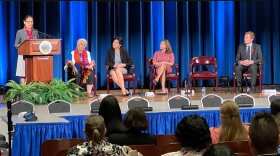President Joe Biden signed a proclamation marking May 5th, 2023 as Missing or Murdered Indigenous Persons Awareness Day. It highlights the injustice and violence that are disproportionately high among Indigenous women and others.
The National Institute of Justice reported in 2016 that 84% of American Indian and Alaska Native women have experienced some form of violence in their lifetime. And 56% reported sexual violence.
Additionally, the Urban Indian Health Institute reported in 2018 that murder was the third-highest cause of death among American Indian and Alaska Native women and girls aged 10-24.

This hits home for Lynnette GreyBull, who is HunkPaPa Lakota and Northern Arapaho. “I am a full blooded Native American woman, and the statistics that hang over my head is: I am the most stalked, raped, murdered, sexually assaulted and suffered domestic violence higher than any other race in our country.”
Statistics are not always a full representation of the issue. The Urban Indian Health Institute found that while 5,712 missing and murdered Indigenous cases were reported in 2016, only 116 were logged in the Department of Justice database.
“The U.S. government has data sets and statistics for just about everything in this country,” GreyBull said. “We can talk about, you know, the price of electricity, the utility costs, housing issues…but if you Google any Native American data, you will find some scarcity there. ... I can't believe that even in 2023, I am still advocating against the same statistics that drove me to start my nonprofit organization.”
GreyBull founded Not Our Native Daughters, a national advocacy group for missing and murdered Indigenous women. She often sits with the victims of these families.
Despite the work she has put into it, she said change won’t come without more allies. “We need to protect public safety and all of these different entities that our country has built upon to create justice and social justice.

“We need all hands on deck to try to make a mark on the statistics that plague Indian Country. If we don't have the partnerships from other people who care about humanity, we're not going to make a difference in these statistics.”
Many states – including Colorado, New Mexico, Utah and Wyoming – have set up MMIR task forces to search for missing Indigenous people and properly log cases.
Still, GreyBull wants to see federal and local law enforcement step up for these families.
“We have these systems in place to protect children,” she said. “But when it comes to Native American children or Native American victims, there's a discrimination there and there's a roadblock.”
She also wants the media to cover these victims more often – and in a positive light. Wyoming’s Missing and Murdered Indigenous People 2021 report found that only 30% of Indigenous homicide victims had newspaper media coverage, as compared to 51% of White homicide victims.
“Native American women don't just die physically when we become murdered or missing,” she said. “We also die in data and in the media. That shouldn't be so."Lynnette GreyBull, founder of Not Our Native Daughters
“And it takes a lot of us to come together to change that. And the more of us that spread this message, that message of social justice, the more impact that we're going to be able to make.”
This story was produced by the Mountain West News Bureau, a collaboration between Wyoming Public Media, Nevada Public Radio, Boise State Public Radio in Idaho, KUNR in Nevada, the O'Connor Center for the Rocky Mountain West in Montana, KUNC in Colorado, KUNM in New Mexico, with support from affiliate stations across the region. Funding for the Mountain West News Bureau is provided in part by the Corporation for Public Broadcasting.






